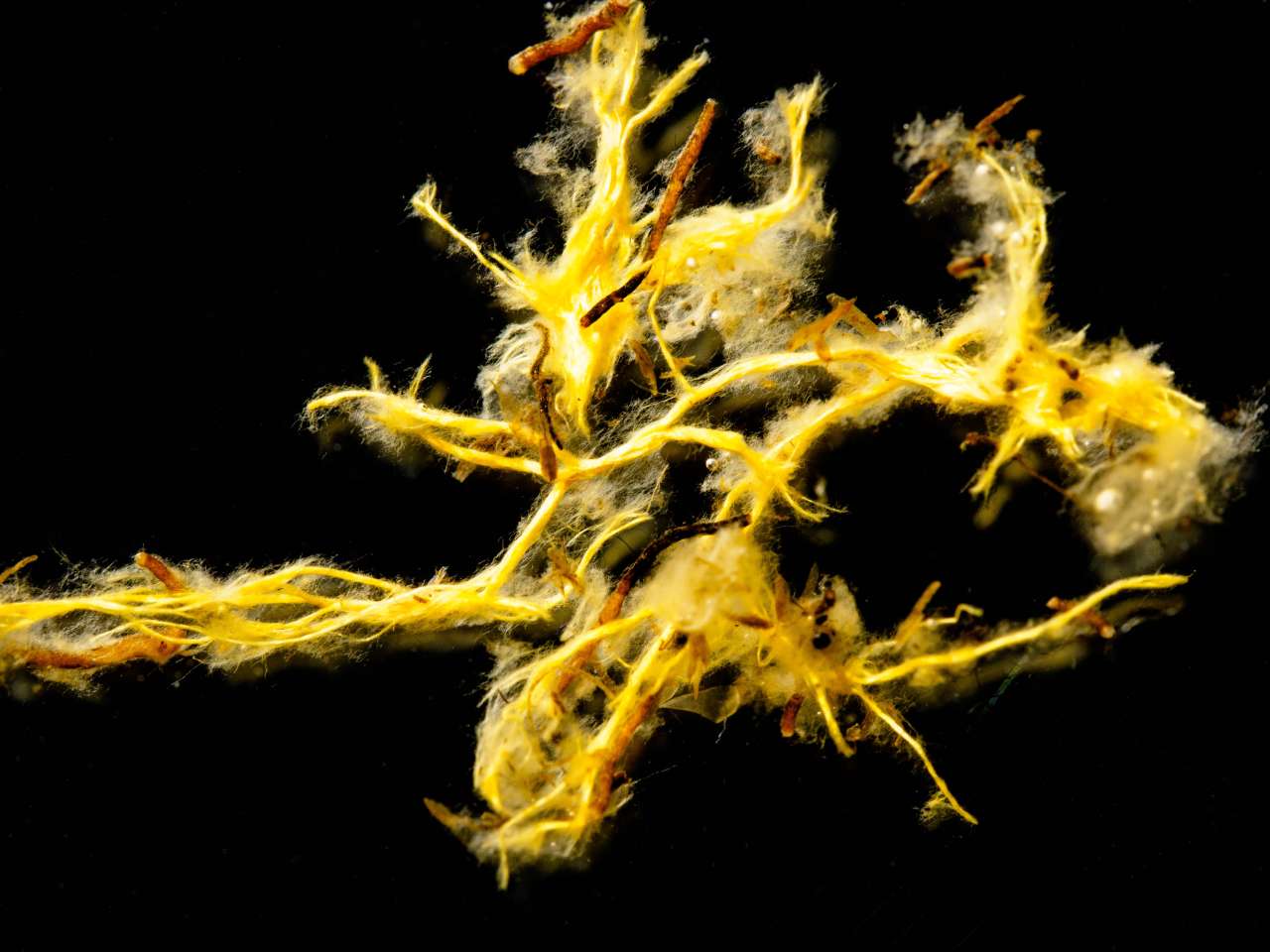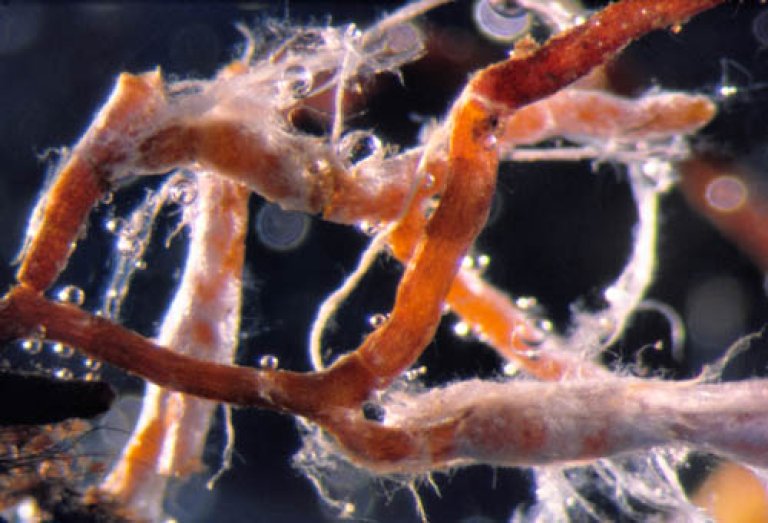Mykorrhiza – trærnes usynlige støttespiller

Mykorrhiza dannet av soppen Piloderma croceum.
Foto: Frank Kidder
Soppene er grunnpilarer i skogøkosystemer. De sørger for at dødt organisk materiale brytes ned og resirkuleres videre i naturen. Uten sopper ville verden bli begravd i dødt organisk materiale.
Soppene består av tynne tråder, såkalte hyfer, som skiller ut tallrike enzymer. Disse bryter ned organisk materiale i sin nærhet. De fleste soppene ernærer seg på denne måten og kalles nedbrytersopper. Men det finnes en annen gruppe sopper, som ikke klarer å skaffe seg næring på egen hånd, men isteden trenger en plantepartner for å få det til – mykorrhizasoppene.
Hva er mykorrhiza?
Ordet «mykorrhiza» oversatt fra gresk betyr «sopprot» (mykos = sopp og rhiza = røtter) og beskriver en symbiose, et gjensidig fordelaktig samliv, hvor mykorrhizasoppenes hyfer og plantenes finrøtter utveksler næringsstoffer. Sopphyfene vokser inni eller mellom rotcellene, eller danner en kappe av sopphyfer rundt finrøttene. Gjennom denne kontaktflaten får soppene sukkerforbindelser fra plantene. Til gjengjeld skaffer de vanskelig tilgjengelige næringsstoffer som fosfor og nitrogenforbindelser samt vann til plantene. Fordi mykorrhizasoppenes hyfer sprer seg i lange avstander fra røttene på leting etter næringsstoffene, øker de betraktelig effektiviteten av næringsopptak for plantene.
Bidrar til karbonlagring
Omtrent 85 % av karbon i boreale skoger ligger lagret i jorda. I lang tid var gjengs oppfatning at dette karbonet kommer fra overjordiske planterester. Nyere undersøkelser har imidlertid vist at så mye som 50 til 70 % av karbonet i jorda kommer fra røtter og mykorrhizanettverk. Fordi mykorrhizasoppene gjennom sitt samliv med plantene i stor grad har mistet evnen til selv å bryte ned ved og planterester, er de avhengige av næringen de får fra trærne. Gjennom fotosyntesen fanger trærne CO2 fra atmosfæren og frakter det, i form av sukkerforbindelser, ned i bakken til finrøttene og derfra videre til symbiosepartnerne – soppene. Når soppene og deres hyfer etter hvert blir brutt ned, blir dette karbonet lagret i jorda.
KONTAKTPERSON


KONTAKTPERSON

Publikasjoner
Sammendrag
Det er ikke registrert sammendrag
Forfattere
Isabella Børja Douglas L. Godbold Jan Světlík Nina Elisabeth Nagy Roman Gebauer Josef Urban Daniel Volařík Holger Lange Paal Krokene Petr Čermák Toril Drabløs EldhusetSammendrag
Global warming will most likely lead to increased drought stress in forest trees. We wanted to describe the adaptive responses of fine roots and fungal hyphae, at different soil depths, in a Norway spruce stand to long-term drought stress induced by precipitation exclusion over two growing seasons. We used soil cores, minirhizotrons and nylon meshes to estimate growth, biomass and distribution of fine roots and fungal hyphae at different soil depths. In control plots fine roots proliferated in upper soil layers, whereas in drought plots there was no fine root growth in upper soil layers and roots mostly occupied deeper soil layers. Fungal hyphae followed the same pattern as fine roots, with the highest biomass in deeper soil layers in drought plots. We conclude that both fine roots and fungal hyphae respond to long-term drought stress by growing into deeper soil layers.
Sammendrag
In this study, we surveyed the long term effects of liming and fertilizing in old Scots pine stands on the ectomycorrhiza (ECM) colonization, tree growth and needle nutrient concentration 35 years later. Four mature stands of Scots pine on low productive mineral soil were limed in 1959 and 1964 with total doses of limestone ranging from 3 to 15 Mg ha1 and fertilized with nitrogen (N) in 1970. Thirty-five years after the first liming treatment, all stands were analysed for tree growth and needle nutrient concentrations and two of the stands were also analysed for ECM colonization. ECM colonization increased significantly with liming from 61.5% in the control plots to 88% in the plot with the highest limestone dose...
Forfattere
Pavel Cudlin Barbara Kielisziewska - Rokicka Maria Rudawska Tine Grebenc O Alberton Tarja Lehto Mark R. Bakker Isabella Børja Bohdan Konôpka T Leski Hojka Kraigher Thomas W. KuyperSammendrag
Human-induced and natural stress factors can affect fine roots and ectomycorrhizas. Therefore they have potential utility as indicators of environmental change. We evaluated, through meta-analysis, the magnitude of the effects of acidic deposition, nitrogen deposition, increased ozone levels, elevated atmospheric carbon dioxide, and drought on fine roots and ectomycorrhizal (ECM) characteristics. Ectomycorrhizal colonization was an unsuitable parameter for environmental change, but fine root length and biomass could be useful. Acidic deposition had a significantly negative impact on fine roots, root length being more sensitive than root biomass. There were no significant effects of nitrogen deposition or elevated tropospheric ozone on the quantitative root parameters. Elevated CO2 had a significant positive effect. Drought had a significantly negative effect on fine root biomass. The negative effect of acidic deposition and the positive effect of elevated CO2 increased over time, indicating that effects were persistent contrary the other factors. The meta-analysis also showed that experimental conditions, including both laboratory and field experiments, were a major source of variation. In addition to quantitative changes, environmental changes affect the species composition of the ectomycorrhizal fungal community.
Sammendrag
Det er ikke registrert sammendrag
